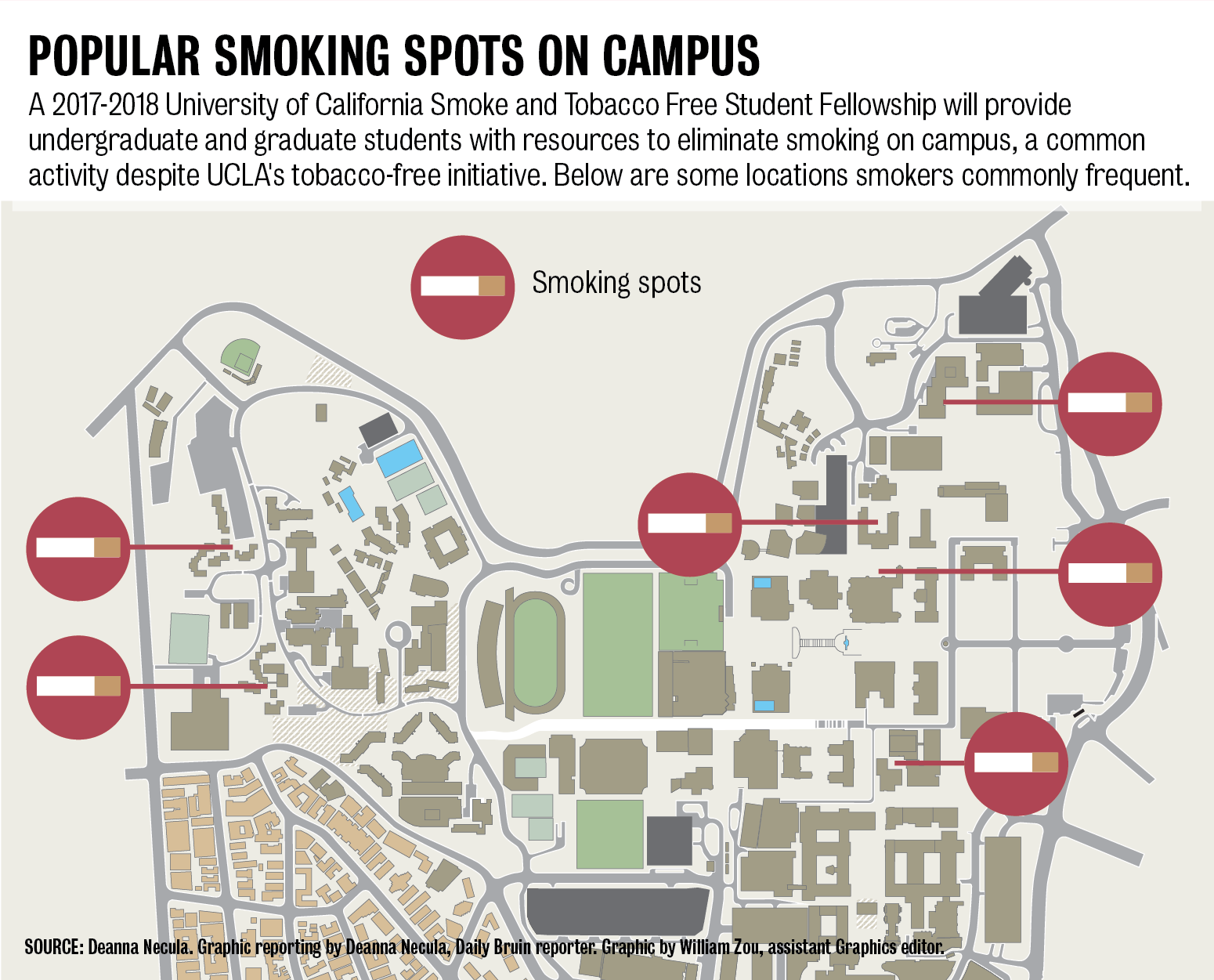Students study ways to improve effectiveness of UC smoking ban

By Deanna Necula
May 22, 2017 9:14 p.m.
Since UCLA was designated a smoke-free campus, tobacco use has shown mixed signs of abating.
The University of California instated the UC Smoke & Tobacco Free Policy to eliminate all use of tobacco products on campus in 2014. However, the ongoing use of tobacco products on campus has encouraged students to investigate the efficacy of the ban and develop strategies to combat continued tobacco smoking.
To encourage undergraduate involvement, the UC created the UC Smoke and Tobacco Free Student Fellowship in 2016, which awards $12,000 to a student from each campus who is committed to pursuing a yearlong project to mitigate the health consequences of smoking on campus.
Elaine Cheung, a third-year neuroscience student and the inaugural winner of the fellowship, said she has been working to improve awareness of UCLA’s status as a smoke-free campus.
According to surveys, more than half of the student body does not know that UCLA is designated as a smoke- and tobacco-free campus, Cheung said.
She said much of the signage designating UCLA as a smoke-free campus has been taken down since campus architects decided it was not aesthetically pleasing. Cheung said she hopes to reinstall the signs near popular smoke spots and campus walkways and upgrade them to include health warnings and contact information for campus resources.
Cheung added she thinks bystanders are often reluctant to bring smoke-free policies to a smoker’s attention. She said Breathe Los Angeles at UCLA, a group aiming to eliminate tobacco use on campus, has been trying to make it easier for students to approach smokers.
“A lot of students feel uncomfortable approaching smokers, so we want to lessen the burden and help them learn how to politely tell smokers to stop and get help.” Cheung said.
Cheung said she hopes to develop workshops in which students can practice confronting smokers and learn how to most effectively communicate with them. She said she is also helping create a Tobacco 101 online educational program that would be included in the drug and sex education curricula incoming first-year students are required to take.
She said she wants to collaborate with more residential assistants on the Hill to encourage them to make residents aware of UCLA’s smoke-free policies among students through flyering and events.
“We’ve seen people be receptive, but we’ve also seen people be indifferent (to the current smoke-free messages),” Cheung said. “That’s why we want to work on communicating a message that will stick with everyone.”
Cheung added she hopes to include marijuana smoking under the umbrella of UCLA’s smoke-free policy in the future, especially given marijuana’s greater popularity among students.
“There’s a lot of misinformation that smoking weed is better for your lungs than smoking tobacco,” Cheung said. “(In reality), smoking weed is worse because you take deeper breaths and hold the smoke in for longer.”
Salma Zaky, a second-year English student, said she never encounters tobacco smokers despite living in Saxon Suites, which is considered a popular smoke spot. She said she most often notices marijuana smokers, who smoke outside her room daily.
“Weed is seen as more socially acceptable, and it’s easy to share,” she said. “Cigarette smoking is seen as just gross.”
Adam Rabb, a health policy management graduate student in the UCLA Fielding School of Public Health, said he thinks researchers should study the environmental effects and popularity of marijuana smoking on campus, particularly given marijuana’s recent legalization in California.
His recent projects have investigated the effectiveness of the UC Smoke & Tobacco Free Policy since it was implemented in 2014.
To measure the policy’s success, Rabb said he counted the number of cigarette butts found at seven popular smoke spots around campus, including in front of Powell Library and the emergency room at Ronald Reagan UCLA Medical Center, 10 weeks before and 10 weeks after the policy was first implemented.
Rabb said he saw a significant decrease in the number of cigarette butts found at smoke spots since the ban. However, he added it is possible smokers became more discreet immediately following the ban but have since become more daring about smoking publicly.
“Even so, I think today it’s become the mentality and the norm that it’s not okay to smoke on campus,” Rabb said.


